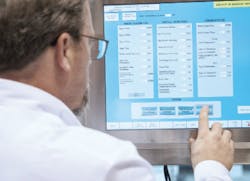It’s well established that digital transformation is revolutionizing pharmaceutical development and manufacturing. But what may come as a surprise is that only 2% of life sciences leaders are realizing the full benefits of their digital transformation initiatives across the core processes of their organization. Many organizations have been busy on the front lines of retooling processes and production capabilities to meet pandemic-related needs, and consequently, digital transformation has taken a back seat.
As pharma manufacturers adjust to the new normal of post-pandemic operations, they’re increasingly circling back for more comprehensive assessments on how best to accelerate their digital transformation efforts. In doing so, many companies are finding that the key is to embed these initiatives more fully into companies’ overall strategy for a smoother transformation toward a more productive digital environment.
Catching up on the transformation to-do list
After scrambling to implement measures to maintain safe operations on the factory floors while also adapting production toward medicines urgently needed during the pandemic, many pharma companies are finally able to take stock of how their businesses have fundamentally changed. It’s especially critical for the sector to catch up, given the likelihood that new public health crises will place similar pressures on the industry in the future.
The good news is that, as pharma refocuses on the marketplace and strategic choices in transforming their information technology and operational technology systems, digital transformation teams in the industry are finding an increasing number of options available for structuring and implementing these transformations. The Industrial Internet of Things (IIoT), augmented reality (AR) and related innovations have shown their value to connect people, products and processes together for a more orchestrated and cost-effective operation.
These powerful building blocks for digital transformation enable companies to connect, monitor, analyze and act on data in new ways. AR, in particular, is a highly visual and interactive method of presenting relevant digital information in the context of the physical and operational environment — streamlining the flow of information and instruction to operators to improve efficiency and effectiveness.
However, with these enhanced choices comes the enhanced need for strategy in implementing them. Investment in the technologies alone doesn’t guarantee that the organization will experience the full potential of manufacturing innovations. For that to happen, they cannot just be bolted on; they must instead be fully integrated into the desired business approach and the IT/OT processes that support that approach.
The challenge is compounded by the nature of pharma manufacturing. Production must happen in highly sterile and climate-controlled environments. This creates increased cost, complexity and compliance hurdles. For these reasons, it’s crucial that pharma manufacturers plan and design their implementation strategically and in accordance with their broader business operations.
Three priorities for success
While there’s no single path to success, here are three key priorities that pharma manufacturers must keep in mind when charting the way forward in their digital transformation journeys:
1. Embrace a holistic view of transformation
The true value of connected technologies isn’t simply what they can do for specific operations, but how technologies can enable an entire connected ecosystem. That requires a more holistic view of the design and benefits you want to reap from your connected platform and how this integrates with a broad range of business priorities and stakeholders.
The scope of digital transformation goes well beyond the manufacturing process and analytics. This holistic view of transformations must include comparative analytics across both the organization and its broader network of partners, suppliers and logistics service providers. This will help inform how companies shape a more collaborative digital ecosystem enabled by enhanced access across any location; more options for orchestration and ability to manage devices as separate layers to existing operational equipment; and connectivity with modern tools for practical adoption, such as via tablets, smartphones or AR headsets.
Critically, this holistic mindset must extend to the industry’s view of security. Given that pharmaceutical operations involve tremendous amounts of intellectual property and sensitive information, the wrong approach to digital adoption risks broadening the potential attack surface as companies move from tightly guarded on-premises data management towards a new world of cloud, remote working and internet-enabled devices. It is important to take a comprehensive and proactive approach to security via clear processes around handling, sharing and storing data.
2. Let the desired business outcomes drive the technology choices
Technologies such as AR, machine learning and predictive analytics can be applied to a wide range of use cases. So the questions that should be asked are: which specific functionalities would offer the most benefit your plant, and where should they be applied? The focus should be on what you want to achieve, and then the technology choices follow as a means to do that. Pharma facilities can take advantage of new Process Analytical Technologies (PAT) to improve quality and efficiency, IIoT connectivity to consolidate data for electronic batch records, extended reality technologies to enable their workforce, or digitized tech transfer processes to improve time to market.
Once the focus areas are defined, drill down to consider specific user requirements and iterate backward to define the functional and technical specifications. This can best be achieved by using agile methodologiesto prioritize and dynamically update the list of features to be included in applications — with ongoing testing and verification to ensure they are in line with expectations. Strategic piloting and scaling can then follow as the broader organization is reshaped.
Zeroing in on the right capabilities means also zeroing in on the right data — its nature and usability —to power these capabilities. Think through, for example, how production performance data might be useful both to the line manager seeking to boost efficiency and to the engineers seeking to ensure the machinery is operating at optimal levels. It’s a strategic and proactive approach to help companies better track, contextualize and monitor real-time data against pre-defined measurement criteria.
3. Address the workplace culture and change management components of digital transformation
Implementing new technology capabilities is part of a bigger move to fundamentally change an organization’s mindset. That means workforce culture plays a role at every stage, and the right change management programs must be developed and implemented as part of the transformation. This is essential to demonstrate the effectiveness of the digital transformation program.
Workforce culture is included among the four key areas of consideration laid out in the National Academy of Science and Engineering’s Industrie 4.0 Maturity Index, with which all digital transformation teams in manufacturing should befamiliar. Along with resources, organizational structure and information systems, culture is listed as a key area that requires its own strategy and approach that must be finely balanced for a successful transformation.
It’s rarely the case that a digital transformation program fails because the business chose one set of technology specifications over another. Rather, it’s almost always that the organization’s culture wasn’t supportive of change. In assessing an organization’s readiness for change, make sure that those on the shop floor have the necessary support to adopt these solutions to enhance their own productivity and drive progress in a successful digital transformation strategy.
Pharma companies and other life sciences manufacturers may have lagged in their overall digital transformations in order to focus on immediate pandemic needs, but now they’re charting beyond current circumstances to consider how digitalization transformations can be undertaken in more strategic and powerful ways.
It’s a welcome trend toward more resilient operations, stronger supply chains and enhanced efficiency in production. As this happens, we can make the industry better at bringing the latest treatments to market — driving favorable health care outcomes and making a positive impact on the patients that need them.









